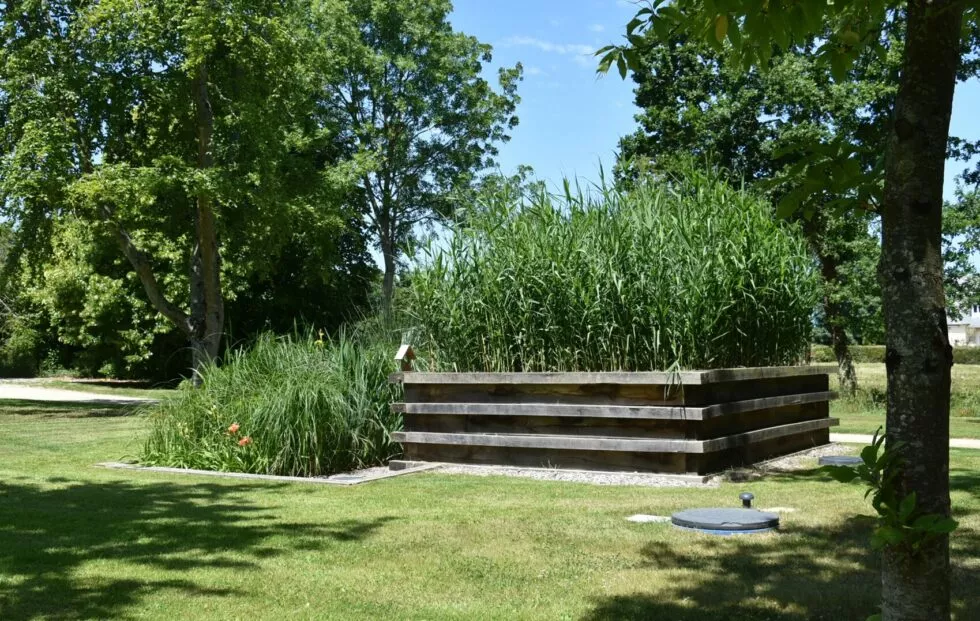Does it have to be a sloping field?

Sanitation Gardens: an innovative and adaptable solution even on flat ground
Sanitation Gardens, or planted filters, are an ecological and aesthetic approach to the treatment of domestic wastewater. This method combines common sense with nature, offering a sustainable and environmentally friendly solution. Traditionally, it is often thought that these systems require sloping ground to function using gravity. However, installation on flat ground is possible and increasingly common thanks to the use of a lifting station.
What is a Sanitation Garden?
The Sanitation Garden is a natural process using a phyto-purification system, offering both aesthetic and ecological advantages. This type of garden harmoniously integrates purifying plants into a landscaped setting, transforming a technical process into a pleasant green space. In addition to playing an important role in wastewater treatment, the Sanitation Garden becomes a visual and ecological asset for the property.
The plants selected for this garden, such as reeds, irises and sedges, also provide botanical diversity that attracts pollinators and enriches local biodiversity. These plants benefit from the natural compost formed by the phyto-purification process, which promotes their growth and flowering.
How a Sanitation Garden works: phyto-purification
Phyto-purification is a set of natural techniques for purifying wastewater with plants. More specifically, it is a method of wastewater purification that relies on a combination of microorganisms and plants in an ecosystem specially designed for this purpose. The principle behind phyto-purification is simple: a plant filter is created to collect wastewater from homes.
The wastewater from the home arrives on the surface of the filter which is planted with reeds. The role of the reeds is mainly mechanical: the development of the stems and rhizomes maintains the permeability of the filter over the long term, and the roots as a whole harbour an ecosystem that is very rich in bacteria and other micro-organisms. The reed filter is divided into two parts that are fed alternately. The upper layer of the filter is made up of sand which acts as a sieve, retaining solid matter on the surface of the filter. This matter will quickly compost while the water passes vertically through the entire filtering bed. The bacteria present in the filtering bed will digest the pollution and the water continues on its way to the infiltration zone.
Adaptability to flat terrain
Contrary to what one might think, it is not essential to have sloping ground to install a Sanitation Garden system. Although gravity naturally facilitates the movement of water, technical solutions exist to compensate for the absence of a slope.
Use of a lifting station
As its name suggests, a lifting station is used to send wastewater, thus facilitating its flow to the treatment system. This means that even if your land does not have a gradient of more than one metre, you can still consider installing a Sanitation Garden.
The lifting station operates via a simple but powerful mechanism that captures wastewater and propels it to a higher treatment point. This system is particularly advantageous in areas where the terrain is flat or slightly sloping. In addition, it offers installation flexibility that allows it to adapt to different types of soil and terrain configurations.
Furthermore, the use of a lifting station is not limited to flat terrain. It can also be beneficial in situations where the gradient is insufficient to allow the natural flow of wastewater. This broadens the possibilities for owners who wish to install an ecological sanitation system, while respecting the natural constraints of their land. As a result, the lifting station is a tool for anyone who wants to enjoy the benefits of a Sanitation Garden, without being limited by the topography of their garden.
The advantages of Sanitation Gardens
An environmentally friendly solution
Sanitation Gardens allow solid matter to be broken down directly into compost on site, thus eliminating the need for transport and the associated pollution. Thanks to these gardens, the energy normally used for waste treatment in water treatment plants is saved. Only French products are used when installing the gardens. To reduce the carbon footprint, the focus is on the use of local resources, for example, the plants and aggregates come from the client’s region.
An aesthetic asset
Like a traditional green space, the Sanitation Garden contributes to the aesthetics of your garden. The plants are chosen not only for their performance and usefulness, but also to add a decorative touch to the space. The device integrates easily into the decor of the house or the area where it is installed.
Gardening maintenance
The Sanitation Garden is maintained in the same way as a conventional garden, with annual mowing being the only necessity. The vegetated filter is generally cleaned every ten years, without the need for any cleaning products.
Conclusion
In conclusion, Sanitation Gardens offer an innovative and ecological solution for wastewater treatment, transforming a technical necessity into an aesthetic and sustainable asset for properties. Although traditionally associated with sloping land, these systems can be installed on flat land thanks to the use of a lifting station. What’s more, these gardens enrich local biodiversity and reduce the carbon footprint by favouring local resources. By reconciling technology and nature, Sanitation Gardens represent an environmentally friendly approach, while blending perfectly into the landscape and requiring minimal maintenance.

